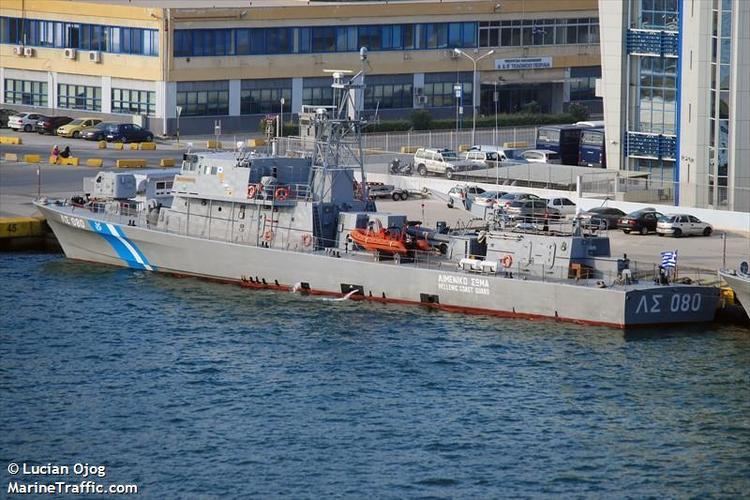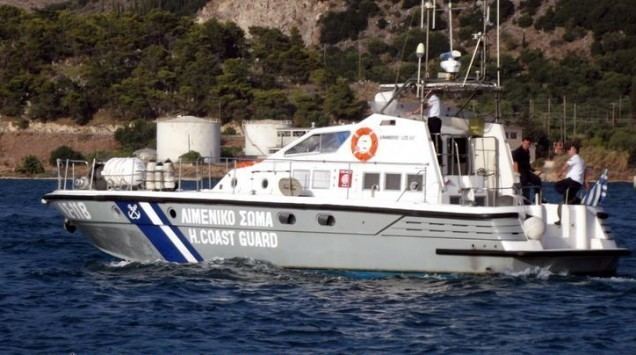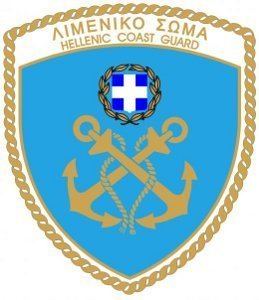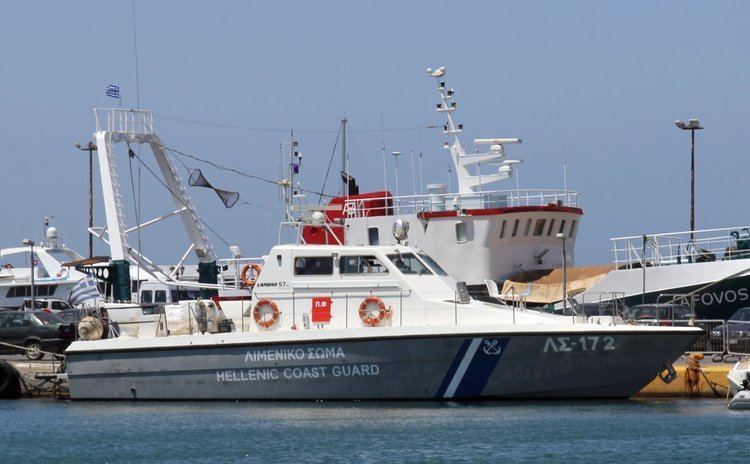Active 1919 Type Coast Guard Color Cyan, White & Gold Transport Cessna 172 | Size 7,000 Founded 1919 Patron Saint Nicholas | |
 | ||
Commandant Vice Admiral Stamatios Raptis Patrol Reims-Cessna F406 Caravan II Similar Hellenic Navy, Hellenic Armed Forces, Hellenic Ministry of National, Hellenic Air Force, Hellenic Army | ||
Hellenic coast guard sa ar4 intercept turkish navy tuzla class
The Hellenic Coast Guard (Greek Λιμενικό Σώμα-Ελληνική Ακτοφυλακή – Limeniko Soma-Elliniki Aktofylaki – lit. "Port Corps-Hellenic Coast Guard") is the national coast guard of Greece. Like many other coast guards, it is a paramilitary organization that can support the Hellenic Navy in wartime, but resides under separate civilian control in times of peace. It was founded in 1919 by an Act of Parliament (N. 1753/1919) and the legal framework for its function was reformed in 1927. The current name is specified in Law 3022/2011.
Contents
- Hellenic coast guard sa ar4 intercept turkish navy tuzla class
- Hellenic coast guard opv 050 arkoi
- Organization
- Role and responsibilities
- Personnel
- Fleet
- Aircraft fleet
- HCG facilities
- References

Hellenic coast guard opv 050 arkoi
Organization

The Hellenic Coast Guard Force is currently under the authority of the Ministry of Shipping and Island Policy. The Hellenic Coast Guard Force is headed by the Senior Coast Guard Officer who has the rank of Vice Admiral (Antinavarchos).

The basic roles of the Hellenic Coast Guard are law enforcement at sea, search and rescue, marine safety, preventing sea pollution, fisheries patrolling, preventing illegal immigration and drug interdiction.

In order to perform these roles, the Coast Guard operate a number of patrol boats of various sizes (6m to 60m) and different types (RIBs, coastal patrol boats, offshore patrol boats, lifeboats and pollution control vessels). On land the Hellenic Coast Guard is equipped with cars and motorcycles.
The Hellenic Coast Guard operates the Maritime Rescue Coordination Center (MRCC) in Piraeus and the Emergency Radio Communications Station SXE at Aspropyrgos (38°02′12.5″N 23°35′7.5″E). The Hellenic Coast Guard also operates the Vessel Traffic Service (V.T.M.I.S.) at busy sea lanes, currently around the ports of Piraeus, Elefsis, Lavrion and Rafina.
Between May 21, 1964 and 1980 the Hellenic Coast Guard had its own special flag, which was derived from the Greek Ensign with the addition of the crossed anchors badge on the center of the white cross.
Role and responsibilities
The main activities of the Hellenic Coast Guard are defined in the present legislation and specified within its institutional framework of operation. These activities are the following:
Personnel
Most officers in recent years are graduates from higher education establishments, including the Merchant Marine Academies. After recruitment new officers study for one year at the Hellenic Naval Academy. Petty officers are trained for nine months at Palaskas Naval Training Centre and lower rank enlisted men are trained at Scholi Limenofylakon at Piraeus. With law Law 4029 of 2011, a volunteer Auxiliary Coast Guard was established. The Officers of the Hellenic Coast Guard have the same ranks as the Officers of the Hellenic Navy and similar insignia, replacing the curl with two crossed anchors. The Petty Officers (Ratings) also use rank insignia similar to those of the Hellenic Navy, replacing the speciality symbol with the crossed anchors badge.
Fleet
As of 2015, the structure of the Hellenic Coast Guard predicts a fleet consisting of five Offshore Patrol Vessels (OPVs) sized 45–60 metres in length and of 300-450 tonnes displacement, six to twelve Patrol boats with lengths of 25–30 metres and more than fifty Coastal Patrol Vessels of various types with lengths of 14–20 metres. In addition the Hellenic Coast Guard operates a large number of fast Rigid-Inflatable Boat (RIB)/Special Forces vessels as well as eleven Lifeboats. Currently the Hellenic Coast Guard fleet in its totality consists of approximately 240 vessels of all types.
Aircraft fleet
The Hellenic Coast Guard operates a small fleet of fixed wing aircraft based at Tatoi (Dekelia) Air Base, (LGTT, 38°06′35.1″N 23°46′55.5″E). Its four AS 332 Super Puma Search and Rescue (SAR) helicopters are operated by the Hellenic Air Force 384 Squadron, based at Elefsis Air Base (LGEL), with mixed Air Force and Coast Guard crews.
HCG facilities
- New headquarters and VTMIS operations centre: 37°56′33″N 23°37′35″E
- Old headquarters and SAR coordination centre: 37°56′23.5″N 23°38′55″E
- Mooring for Open Sea Patrol Vessels (Keratsini): 37°57′25.7″N 23°36′39.7″E
- Coast Guard apron at Tatoi Air Base: 38°06′35.1″N 23°46′55.5″E
- Aspropyrgos Maritime Communications Radio Station SXE: 38°02′12.5″N 23°35′7.5″E
- Piraeus Central Port Authority: 37°56′23″N 23°38′24″E
- Enlisted men training facility (Σχολή Λιμενοφυλάκων): 37°56′10.3″N 23°37′40.4″E
- Piraeus VTMIS AIS receiver 002393200 37°56.369′N 023°38.381′E
- Psyttaleia Island VTMIS AIS receiver 002391100 37°56.620′N 23°35.664′E
- Patras VTS 38.24617°N 21.72886°E / 38.24617; 21.72886
- Thessaloniki VTS 40.63802°N 22.92522°E / 40.63802; 22.92522
- Corfu Island VTS 39.62708°N 19.90554°E / 39.62708; 19.90554
- Igoumenitsa VTS 39.48799°N 20.25899°E / 39.48799; 20.25899
- Lavrion VTS 37.71394°N 24.06252°E / 37.71394; 24.06252
- Rafina Port 38°01.347′N 24°0.522′E
